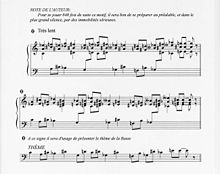Miniature (music)
In classical music, miniature generally refers to a short piece of music for one or a few instruments. Miniature is undifferentiated and, depending on the stylistic context as a synonym for terms such as musical sketch (Engl. Musical sketch ), musical Ekloge (French. Eglogue musicale ), Impromptu , Bagatelle , Rhapsody or Etude used.
Miniature is not a genre of music . In addition to the undifferentiated use, the term is mainly used for short practice pieces and also for longer works of various musical genres with several instruments and / or singing - for example opera or pastoral works - if these works are significantly shorter than is usually the case.
History and use of terms
Metzler Musik Chronik describes the character pieces of the French lutenists in the 17th century as well as the "program pieces" of the French composers François Couperin (1668–1733) and Jean-Philippe Rameau (1683–1764) as early miniatures. Some works by Carl Philipp Emanuel Bach (1714–1788) and Ludwig van Beethoven's (1770–1827) Bagatelles are also assigned this term.
With the Romantics , the miniature is an expression for “letting a lyrical feeling be loud”, “capturing a musical moment of happiness”, for example with Felix Mendelssohn Bartholdy (1809–1847) ( songs without words ), Robert Schumann ( 1810–1856) ( Scenes from Children , Colorful Leaves ) and Johannes Brahms (1833–1897) (the late Intermezzi).
From the point of view of the music theorist Theodor W. Adorno , it was Robert Schumann's publications "that actually brought the musical miniature, the 'little piece' into the world".
Practice piece
Examples of miniatures are practice pieces (études) for keyboard instruments (e.g. piano , organ ), stringed instruments (e.g. guitar , pestle lute ) and wind instruments (e.g. flute , clarinet ). Practice pieces for purely rhythmic percussion instruments are not referred to as miniatures.
Artistic composition
In the 20th century in France, the miniature can be found in music, especially among composers with "an ideal that puts the small over the big, the miniature over the monumental". Eric Satie (1866–1925), a pioneer of minimal music , wrote the miniature Vexations around 1893 , which once played lasts about two minutes, but which - according to Satie's instructions - is played 840 times to make a monumental work of about 24 hours .
The work of the Austrian Anton Webern (1883–1945) includes many miniatures, the layout and execution of which - and what is not included in them - has been intensively examined.
The term miniature is also not uncommon in modern classical music.
Short form of a certain genre of music
The prefix “miniature” (French (en) miniature ) or the sole use of “miniature” in the context of usually longer compositions of various musical genres indicates that a work so designated is considerably shorter than other works of this genre . Examples are the "miniature opera" (French: opéra miniature ), the "miniature gavotte " and the "miniature pastoral ".
Individual evidence and explanations
- ↑ Patricia Hall and Friedemann Sallis: A Handbook to Twentieth-Century Musical Sketches . Cambridge University Press, December 2, 2004, ISBN 978-0-521-80860-6 .
- ^ Marie-Claire Le Moigne-Mussat, Herbert Schneider and Jean Gribenski: D'un opéra l'autre: hommage à Jean Mongrédien . Presses Paris Sorbonne, 1996, ISBN 978-2-84050-063-6 , p. 38.
- ↑ Jim Samson: The Cambridge Companion to Chopin . Cambridge University Press, December 8, 1994, ISBN 978-0-521-47752-9 , p. 131.
- ^ A b Arnold Feil: Metzler Musik Chronik: From the early Middle Ages to the present . Springer-Verlag ,, ISBN 978-3-476-00145-0 , p. 595.
- ^ Theodor W. Adorno: Musical writings . Suhrkamp Verlag, 1984, ISBN 978-3-518-57696-0 , p. 701.
- ↑ 13 Miniatures: for piano . Möseler, 1980.
- ↑ 8 miniatures: for piano . Wolfgang G. Haas, 1998.
- ^ Rudolf Wagner-Régeny: Five miniatures for guitar . Medium Publisher, 1951.
- ↑ Carsten Timpe: 5 miniatures for the Stössel lute - in French lute tablature and modern notation (guitar, piano) . epubli, July 27, 2014, ISBN 978-3-7375-0123-1 .
- ↑ Yoram Paporisz: Seven miniatures: for flute . Gerig, 1974.
- ↑ 12 miniatures: for solo bass clarinet in Bb . Music and book publisher W. Feja, 1991.
- ^ Paul Sacher Foundation (Basel, Switzerland). International Symposium: Classicist Modernism in 20th Century Music . Amadeus-Verlag, 1997, ISBN 978-3-905049-73-2 , p. 105.
- ^ Richard Skinner: Vade Mecum: Essays, Reviews & Interviews . John Hunt Publishing, September 25, 2015, ISBN 978-1-78535-025-2 , p. 99.
- ↑ Hartmut Krones: Anton Webern: Personality between art and politics . Böhlau Verlag Vienna, January 1999, ISBN 978-3-205-99072-7 , p. 227.
- ↑ Dieter Rexroth: Opus Anton Webern , Quadriga-Verlag (1983), p. 38.
- ↑ Eva-Maria Houben: The suspension of time: the utopia of unlimited present in the music of the 20th century . Franz Steiner Verlag, 1992, ISBN 978-3-515-05847-6 , p. 44.
- ↑ Annette Kreutziger-Herr: A dream from the Middle Ages: the rediscovery of medieval music in modern times . Böhlau Verlag Köln Weimar, 2003, ISBN 978-3-412-15202-4 , p. 234.
- ^ Leon Meyer: Pictures of the music . Hulton Getty picture, 1996, ISBN 978-3-89508-216-0 , p. 62.
- ↑ Clavier . Instrumentalist Company, 1974, p. 26.
- ^ Benjamin G. Cohrs: Christmas Cantatas - once different , Klassik heute, December 2, 2002; accessed on March 23, 2017.







